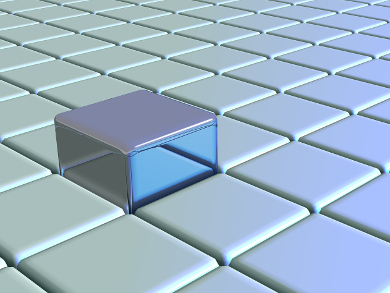Noble-Metal Nanocubes
For many years nanotechnologists, chemists, and materials scientists have sought ways to make tiny cubes of noble metals, such as silver. Indeed, protocols for making silver nanocubes have been rather successful. They have been used, e.g., as catalysts for the epoxidation of ethylene (where spherical or irregular nanoparticles were never good enough).
Another use is as templates for making nanoboxes of gold, platinum, or palladium, within which other compounds, such as therapeutic agents, might be hosted. They have also been employed in photonics and sensing, and as agents for localized surface plasmon resonance (LSPR) and surface-enhanced Raman scattering (SERS) spectroscopy.
Unfortunately, despite great efforts to improve production methods, no consistent protocol exists for making high-quality silver nanocubes any smaller than about 25 nm. Below that size, the edges and corners of the cubes are anything but sharp and this rounding diminishes the properties for which such nanoparticles might otherwise be useful.
Smaller Sharp-Edged Cubes using Bromide
Aleksey Ruditskiy and Younan Xia of the Georgia Institute of Technology, Atlanta, USA, have devised a polyol method for making higher quality silver nanocubes, the size of which can be controlled in the range of 13 to 23 nm without the troublesome rounding of edges and corners. The researchers were able to trigger rapid nucleation of silver atoms to form these nanocubes by using a trace amount of bisulfide ions, SH– , which generate primary silver sulfide clusters, which serve as seeds for the growth of the silver nanocubes.
The addition of bromide ions regulates the nanoparticle growth kinetics and also caps the Ag(100) surface, keeping the corners and edges of their nanocubes nice and sharp. Bromide ions are obviously much smaller than bulky organic capping agents, such as poly(vinylpyrrolidone), and so allow the team to make much smaller silver nanocubes than was previously possible. The synthesis takes just minutes for the basic production and any extension to beyond an hour did not improve edge length, sharpness, or quality, although spherical nanoparticles smaller than 5 nm were obtained with longer growth times.
“The nanocubes of 13.4 ± 0.4 nm in edge length constitute the smallest nanocrystals of this kind reported to date,” the team states in the Journal of the American Chemical Society. Moreover, those nanocubes also have sharper corners and edges than the limited known examples of silver nanocubes that are smaller than 20 nm across, which can be shown by Transmission electron microscopy (TEM).
Applications in Plasmonics, Catalysis, and Biomedicine
Such tiny nanocubes represent a system with a vast catalytic surface area and so could lead to a new approach to various synthetic processes. The current approach gives a yield of about 90 % and is both highly reproducible and readily scalable. “The availability of such small and sharp Ag nanocubes will open the door to an array of applications in plasmonics, catalysis, and biomedicine,” the team says.
“We are still refining the protocol to hopefully reach a size of 10 nm or below,” Xia explains. “At the same time, we are using the small silver cubes to fabricate gold nanocages for biomedical applications and platinum or palladium nanocages for catalytic applications.”
Raphael Schneider of the University of Lorraine, Nancy, France, an expert in nanotechnology, organic and organometallic chemistry, sees the potential of these sharp-edged nanocubes: “Based on my experience, the leading applications of these nanocubes should be photonic and catalytic,” he told ChemViews Magazine.
- Toward the Synthesis of Sub-15 nm Ag Nanocubes with Sharp Corners and Edges: The Roles of Heterogeneous Nucleation and Surface Capping,
Aleksey Ruditskiy, Younan Xia,
J. Am. Chem. Soc. 2016.
DOI: 10.1021/jacs.5b13163



